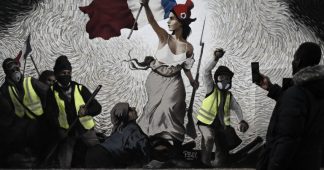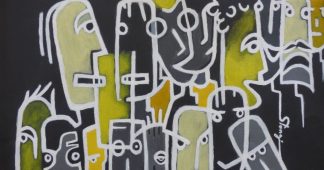In Faces Places and The Gleaners and I, the director trained her camera on people and issues not frequently seen on-screen
By Rachel Donadio
Mar 30, 2019
There’s a scene at the beginning of Faces Places, Agnès Varda and JR’s unassuming 2017 documentary of their road trip around France, when the film director and photographer meet a woman who refuses to move out of her home in public housing once built for families of coal miners, even though the local authorities want to move her elsewhere. Varda, a pioneer of the French New Wave who died on Friday at 90, and JR, the globe-traveling large-scale photographer, take the woman’s portrait, then blow up the image and paste it on the facade of her house.
When the woman comes out of the house to see what they’ve done—sees such a big image of her own face—she begins to cry. Her tears are complicated. But mostly they are about what happens when a person accustomed to being ignored feels seen. Faces Places is a film about making people feel recognized, about making the invisible visible.
I’ve thought about Faces Places, and that scene in particular, a lot in the past few months—ever since demonstrators wearing yellow safety vests have gathered weekly across France, especially at roundabouts on the margins of cities, to protest a fuel-tax hike and the rising cost of living. The “yellow vest” movement is about many things, but above all it is about a desire by citizens to feel seen, to feel recognized and appreciated (in their case by President Emmanuel Macron). Faces Places is not a political movie, but it’s a close and therefore telling look at la France profonde, or the rural and provincial France that so often feels left out of the national conversation in a country whose cultural and political life is centered in Paris.
Faces Places wasn’t the first time Varda had trained her camera on the marginalized in France, making them central, even beautiful. Her 2000 documentary The Gleaners and I was about people in France who scavenge for food—for potatoes that have begun to sprout, for vegetables left behind after outdoor markets. In the movie, which Varda shot from 1999 to 2000, people are still using French francs. It was just before the euro came into use in January 2002. She filmed dumpster divers and rural outcasts. After the release of The Gleaners and I, Varda presented it around France and held public conversations with the audience about the issues it raised, such as food distribution, food waste, and social exclusion. The film had captured the air du temps, or the spirit of the time.
A few months ago, on a gloomy Sunday afternoon in January, I went to hear Varda speak about The Gleaners and I after a screening at the Cinémathèque Française, which was holding a retrospective of her work. I wanted to hear Varda talk about how she chose her material, how she framed it, how she figured out who would be the center of a film and who would be peripheral. Her hair was white on top, and red-brown at the bottom, her signature look. She was jolly and generous with the audience’s questions. “I don’t look for subjects,” she said of her films. “I wait for subjects to find me.” Sometimes she took years to find a project. “Chance has always been my best assistant,” she said.
Varda said that The Gleaners and I was the first time she’d been able to use a small, handheld digital camera, new to the market, and it was easier to get inside people’s lives without an invasive film crew. “People didn’t see the camera so they didn’t know it was cinema,” she said. She had wanted to pay attention to people who were “invisible.” And she did. One of those people was her. For the first time, she put herself in front of the camera. “I felt like I had the right to put myself in the film,” she said. She was nearing 70 and had become interested in the process of aging. People aging, potatoes aging. At the end of her talk, someone shouted from the audience, “You are young, Madame Varda!”
Published at https://www.theatlantic.com/entertainment/archive/2019/03/agnes-varda-dead-90-revisiting-faces-places/586159/











